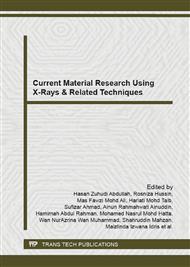p.1
p.6
p.11
p.16
p.20
p.25
p.30
p.35
p.40
Silver Nanoparticles in TiO2 Coatings for Potential Antimicrobial Coatings
Abstract:
This research aims to determine the effect of silver nanoparticles concentrations as antimicrobial coatings when doped to TiO2 coatings. The TiO2 coatings were prepared by sol–gel method initiating Titanium Isopropoxide–Propanol mixture as a precursor solution. The silver nanoparticles (40 nm) were then doped to the coating after sintering at 500°C. Two concentrations of silver nanoparticles, (50 ppm and 1000 ppm), were prepared for comparison in this study. Microstructure and crystalline phase of coatings were evaluated using Scanning Electron Microscope (SEM) and Glancing Angle X-Ray Difraction (GAXRD) technique. The antibacterial test was according to McFarland standard for detecting E.Coli, S.Aerues, fungas and Methicillin-Resistant Staphylococcus Aureus (MRSA). Results show that only coatings with the concentrations of 1000 ppm of silver nanoparticle function as antimicrobial coatings.
Info:
Periodical:
Pages:
20-24
Citation:
Online since:
February 2015
Price:
Сopyright:
© 2015 Trans Tech Publications Ltd. All Rights Reserved
Share:
Citation:


